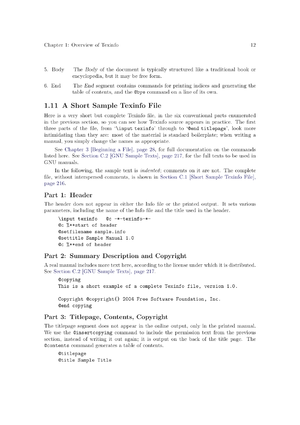Makeinfo

An example of printed Texinfo output; page 25 of the official GNU Texinfo manual.
|
|
| Original author(s) |
Richard Stallman Bob Chassell |
|---|---|
| Developer(s) | Brian Fox Karl Berry |
| Initial release | February 1986 |
| Stable release | 6.4 (23 June 2017) |
| Written in | C, Perl |
| Operating system | GNU |
| Type | Documentation |
| License | GNU General Public License |
| Website | www |
Texinfo is a typesetting syntax used for generating documentation in both on-line and printed form (creating filetypes as dvi, html, pdf, etc., and its own hypertext format, info) with a single source file. It is implemented by a computer program released as free software of the same name, created and made available by the GNU Project from the Free Software Foundation.
The main purpose of Texinfo is to provide a way to easily typeset software manuals. Similar to the LaTeX syntax, all the normal features of a book, such as chapters, sections, cross references, tables and indices are available for use in documents. Using the various output generators that are available for Texinfo, it is possible to keep several documentation types up-to-date (such as on-line documentation provided via a Web site, and printed documentation, as generated using the TeX typesetting system) using only a single source file.
The official Texinfo documentation states that the first syllable of "Texinfo" is pronounced so as to rhyme with "speck", not "hex"; this pronunciation is derived from the pronunciation of TeX, in which the X represents the Greek letter "chi" rather than the English letter "ex". The maintainers state that "Texinfo" should be written with only a capital "T" and the rest of the letters in lower case.
In order to make it possible for several documentation output formats to be updated all at once, upon changing the original Texinfo (.texi) source file, several syntax converters are available that can be used to generate transliterations of the Texinfo file into other formats. Most of these are created using the makeinfo program, which is part of the GNU Texinfo distribution.
Notably, man is not available as an output format from the standard Texinfo tools. While Texinfo is used for writing the documentation of GNU software, which typically is used in Unix-like environments such as GNU/Linux, where man pages are the traditional format for documentation, the rationale for this is that man pages have a strict conventional format, used traditionally as quick reference guides, whereas typical Texinfo applications are for tutorials as well as reference manuals. As such, no benefit is seen in expressing Texinfo content in man page format. Moreover, many GNU projects eschew man pages almost completely, referring the reader of the provided man page (which often describes itself as seldom maintained) to the Info document.
...
Wikipedia
